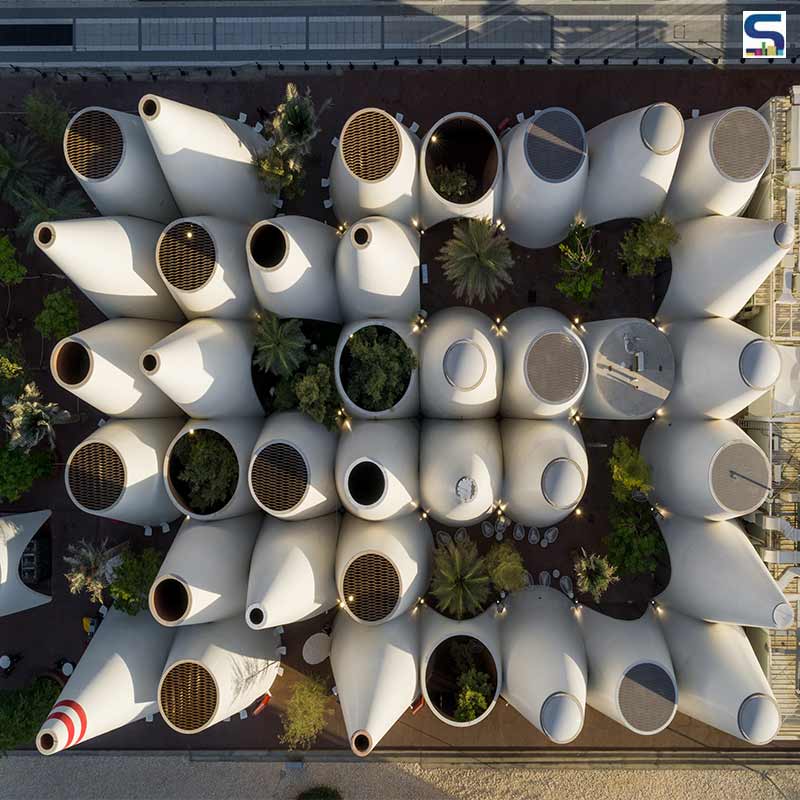
Historical wind towers and climate-regulating properties of the traditional Arab clay architecture inspire the Austrian pavilion. Designed by Vienna-based architecture studio querkraft architekten, the Austrian pavilion reinterprets Dubai’s building traditions through its striking 38 intersecting cones of different heights that form the shape of a pavilion. Know more about it on SURFACES REPORTER (SR).
www.andreas keller-fotografie.de_11zon.jpg)
Set up at EXPO 2020 Dubai, the Austrian pavilion offers adequate space to enter into a multicultural dialogue on questions of a sustainable future. With ‘Austria makes sense’ slogan, the pavilion represented its country in a sensual way. Nestled around three green courtyards, the Austrian pavilion comprises unique room sequences that distinguish the inside and the outside.
www.andreas keller-fotografie.de_11zon.jpg)
The haptic surfaces of the pavilion are made of clay plaster, while the canopy of leaves rustles through the open cones. The pavilion executes a play of light and shadow and brings the audience closer to culture and technical innovations. The use of local building methods and smart climate engineering from Austria makes the pavilion dispense with conventional air conditioning technology even in the hottest desert climate. Compared to similar building types, the energy requirement has been reduced by more than 70 per cent.
www.andreas keller-fotografie.de_11zon.jpg)
The Austrian pavilion has been executed with the economical use of resources. Each cone of the pavilion is constructed from eight different fabricated parts in an igloo system. Post 182 days after the event, the cones of the pavilion had been dismantled into their individual parts and reassembled in a new location in the Arab world.
 Kieran Fraser Landscape Design_11zon.jpg)
Project details
Location: Dubai, UAE
Size: 1.600 m2
Client: Austrian Federal Ministry of Digital and Economic Affairs; Austrian Federal Economic Chamber
Project management: Werner Consult
General planning: querkraft architekten
Project architect: Clemens Russ
Team: Fabian Kahr, Guillermo Alvarez, Konrad Brack, Verena Fessele, Fraym Hanna, Elisabeth Hofstetter, Maja Karska and Felix Zitter
Team (competition): Stefanie Meyer and Tim Stahlhut
Exhibition design: Buro Wien; Ars Electronica Solutions
Visual identity and graphic design: Bleed
Structural engineering: Werkraum Ingenieure; WME Engineering Consultants
Climate engineering: Ingenieurburo P Jung
Landscape design: Kieran Fraser Landscape Design; Green4cities
Fire protection: Design Confidence
Light design: Pokorny Lichtarchitektur
Acoustic engineering: David Haigner
AV/IT engineering: WME Engineering Consultants
Security engineering: WME Engineering Consultants
Architect of records: WME Engineering Consultants
General contractor: Nussli Group
Cost management: Vienna Consulting Engineers
Kitchen planning: Sofia Refrigeration
Geology: Geotechnik Bauingenieure
Visualization: Patricia Bagienski
Model building: Modellwerkstatt Gerhard Stocker Design and Function
Photographs: Andreas Keller, Day Eid, Kieran Fraser, Carmen Egger and Fabian Kahr; Courtesy: querkraft architekten